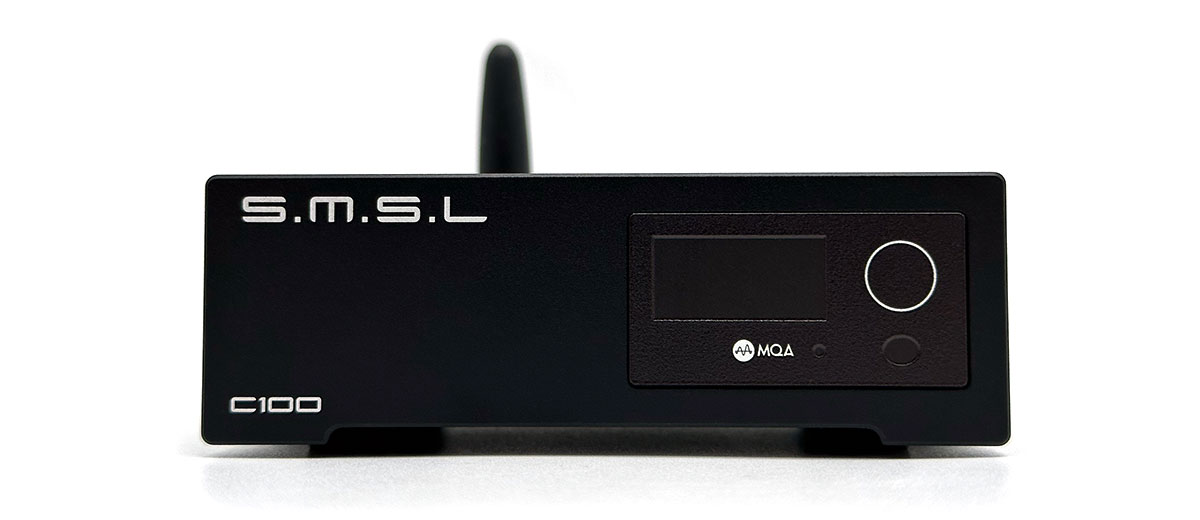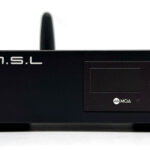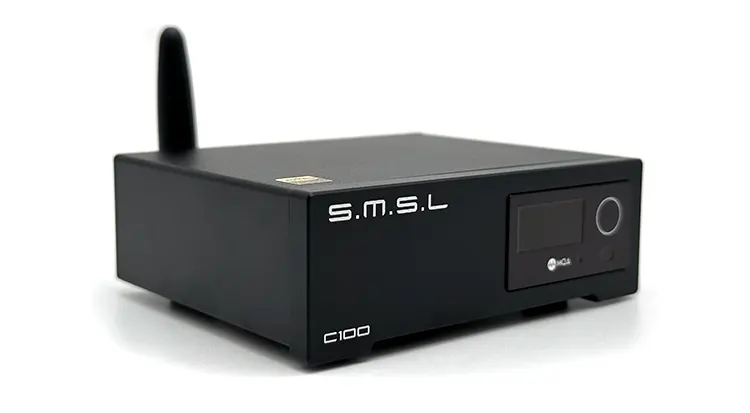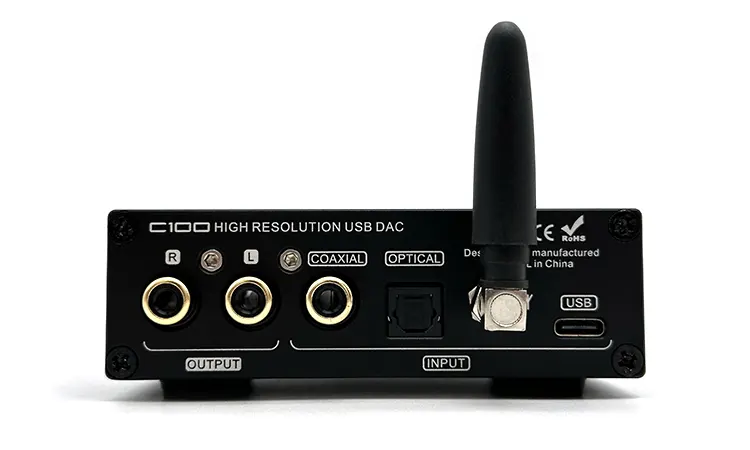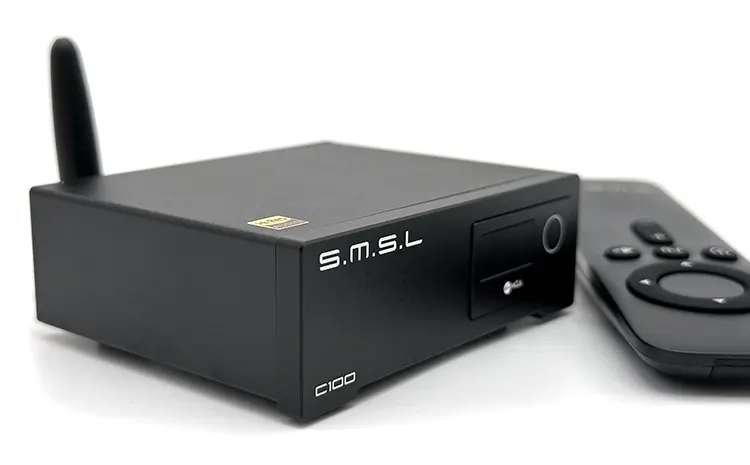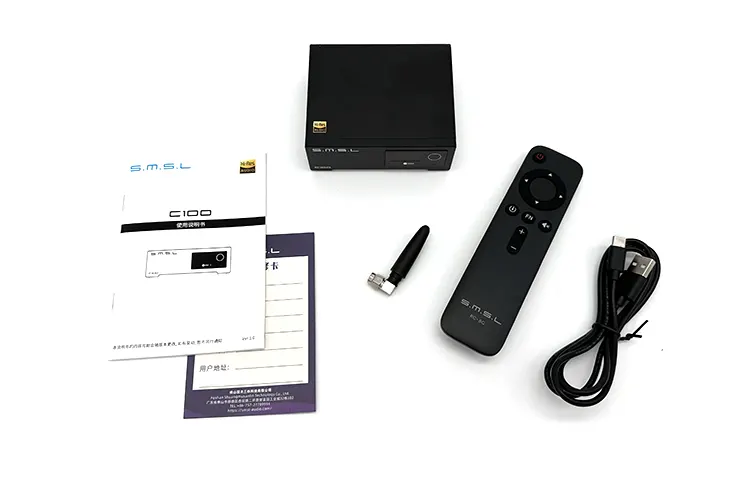In this feature, we review the SMSL C100, which is a compact entry-level desktop DAC supporting up to PCM 32BIT/768kHz and DSD512 decoding. It is priced at $119.
Disclaimer: This sample was sent to us in exchange for our honest opinion. Headfonics is an independent website with no affiliate links or status. We thank Aoshida Audio and SMSL for their support.
To learn more about SMSL products we previously discussed on Headfonics click here.
Note, that this article follows our latest scoring guidelines which you can read here.
The C100 is a new desktop-class DAC from SMSL that sits just below the previously launched SMSL C200.
This is not the first time SMSL has done the shrink-ray treatment and released a lower-tier device in an existing family. However, in the case of the C100, it didn’t only lose weight in the process.
Losing the balanced section of the C200, the calling card of the C100 introduces itself as an ‘ultra-tiny’ DAC which is very fitting to its borderline portable package.
Now, a burning question in my mind aside from whether SMSL has gone too far with the slimming process of the C100 is if the pedigree of the brand remains sonically sound. I’d say that a cute face is wasted if it has poor talent.
Tech Highlights
Officially joining the C200 in SMSL’s lineup, the C100 is surprisingly built around an AK4493S chip from AKM instead of an ESS one to make things consistent. At least I am not surprised by the appearance of yet another AKM DAC from SMSL after reviewing the D-6 recently.
Under the hood, the C200 is still an obvious step up from the C100 noting the presence of balanced outputs in the former. The newer DAC, however, didn’t miss its opportunity to bring in the latest XMOS XU-316 as its USB module and also include MQA as one of its selling points.
The C100 is a simple DAC on its own. This won’t be the case once the provided remote has been added to the equation. From changing filters, turning off the display, and allowing the C100 to be used as a preamp, SMSL taught their palm-sized converter a trick or two.
Reading the numbers of the C100 may not be the best out there but they’re surely not lagging too far behind even compared to some slightly more expensive DACs.
It is also worth mentioning that SMSL took care of ensuring the C100 is powered properly. Since the USB port combines the function of power and data entry, coupled inside is a high-performance power filtering system so listeners can relax knowing their audio is not touched by unwanted noise.
Design
Without any moving parts at all, the C100 is a solid unit that can sit comfortably anywhere. Removing extras from its bigger brother, the missing volume knob and balanced outputs have led to the insignificant footprint of the C100.
The front plate of the unit is affixed separately from the rest of the frame. And instead of simply shaping it in the same rectangular shape, short extensions looking like feet can be seen dangling on both ends.
Trading some of the conveniences of the C200, the C100 is alternatively given MQA functionality which is made obvious by the printed logo below the seven-segment display. The logo itself doesn’t light up so there is a dedicated indicator on the side.
I also noticed that the protective material SMSL chose to cover the display is not completely transparent. It makes it easier for the display to hide when turned off, which for me is a cleaner execution.
I/O
Left on standby, the C100 won’t be too demanding for battery-powered devices since it will only sip less than 0.1W for its essential components. This number will go up a bit to around 5W once the device is fully up and running.
While it may seem like a very simple box, the C100 starts with a fairly nice USB-C input that can read music libraries of up to 32bit/768kHz PCM and DSD512. It then adds the usual host of other connectivity options such as optical, coaxial, and Bluetooth. The Bluetooth spec though is curiously omitted.
On the other side of the business, the pair of RCA outputs SMSL installed to the C100 are gold-plated and high quality. It will push out 2Vrms and a dynamic range of 121dB.
Controls
There’s one less cable to hide noticing that the C100 runs completely fine from a single USB data cable. Not demanding a wall wart, what it needs is a USB port with enough juice to support this extra load. This is crucial for those using USB hubs since in my experience you’ll have to use powered kinds for the C100 to turn on.
In the beginning, it boots immediately upon plugging in but it can remember to start on standby the next time if preferred.
After cycling through a startup sequence, the display rests to show the sampling rate instead of the volume level which by the way is set to max by default. A remote is included since it is the only way to use the C100 as a preamp.
Remove the remote and the C100 is still usable through a touch-sensitive area on the right side. Aside from putting the unit to sleep, it is also the quickest way to change inputs.
MQA listeners will get to go back and forth through their library without lifting a finger or pressing a button. Both the indicator and the display snappishly indicate that an MQA file is playing.
Packaging & Accessories
At its asking price, it is to be expected that not a lot of frills are given to the packaging of the C100. Less is more, right? Plus, all that savings goes to performance.
Having the same design SMSL has used for years, I immediately took the initiative to open the box. Expectedly, there’s a lot of black protective padding inside that surely kept the device safe during transit.
Then there’s the paperwork that’s amusingly even bigger than the footprint of the C100. Afterward, the DAC, remote, and accessories are finally available to reach only being separated into their respective cutouts.
Sound Impressions
All testing was done with an SMSL HO100 and Earmen ST-Amp amplifier, combined with a Sennheiser HD560s and a HarmonicDyne Athena for headphone choices.
Summary
I started the listening part of this review honestly overlooking that there is an AKM chip inside. While it is only one part of the equation, it wasn’t hard to notice the lack of tension and fragility to the sound of the C100 which to me is a nod to its choice of DAC chip.
After testing a few songs, it turned out that I wasn’t just imagining the disciplined yet broad-sounding wallop of the bass. Like a refreshing breeze, the bumped-up mid-bass comes and goes without causing a stir. Lacking it may be in texture, it has a gentle reverb that helps open up a scene while not necessarily asking for too much attention.
Likewise in the midrange, the smooth timbre of guitars is bonded to its motivation to not sound sterile. The C100 tries its best to balance the suppleness it supplements to each pluck by injecting some level of detail but it is still not the most resolving DAC out there.
Listening to male singers maintaining a lower tone, there is wholeness and power to the attack of the lyrics. This fullness dies down a bit as it climbs the upper registers where a certain level of shout can be heard on certain mixes.
The presence and delivery are there for electric guitars. Just don’t expect too much on the subtleties since the C100 can blunt the edges a bit. This, however, suits instruments like the violin, observing that the depth of each note is being given a nice balance of body and zing to not sound too dry.
Staging & Dynamics
With a sturdy portrayal of notes as they happen in a well-defined bearing, the C100 is skilled enough to be used with less worry that instruments stumble their placement. How the C100 has been tuned though causes certain regions to be emphasized which somehow affects evenness.
The soundstage at least is honestly placed and is quite impressive for the price. Both its width and height are surprisingly capable. Going back to reality, the layering is still a weak area here which can choke up when playing a busy song.

